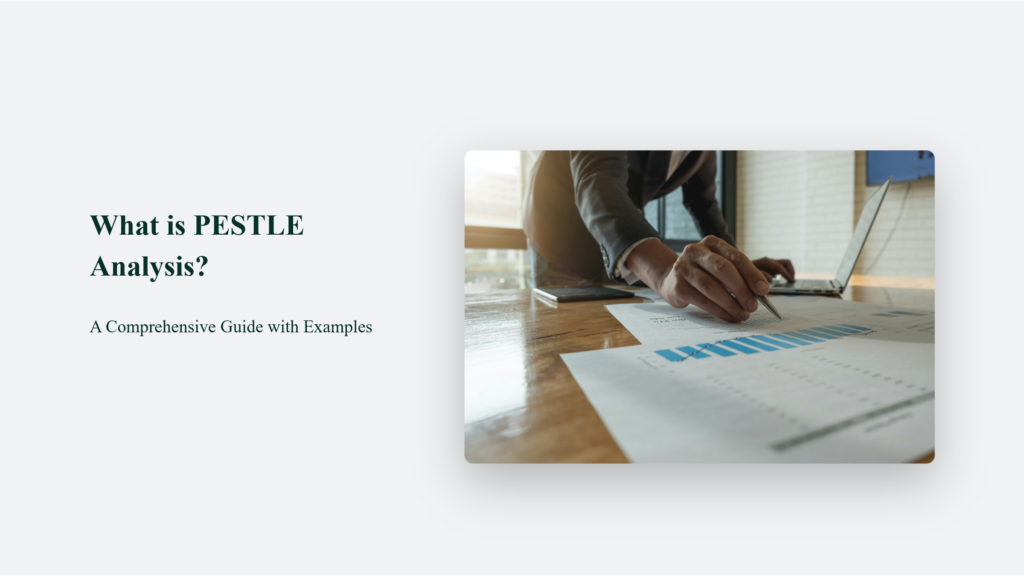In today’s fast-paced and ever-changing business world, organizations must remain vigilant and adaptable to stay ahead of the curve. As a savvy business leader, you know that understanding the external factors influencing your industry is crucial for making informed strategic decisions. It is where PESTLE analysis comes in – a powerful tool that helps you navigate the complex macro-environment and identify potential opportunities and threats.
But what is PESTLE analysis, and how can it benefit your organization? In this comprehensive guide, we’ll explore its key components, benefits, and real-world examples. So, let’s get started!

What is PESTLE Analysis?
PESTLE analysis is a powerful strategic planning tool businesses and organizations use to analyze the external macro-environment factors identify threats that can impact their operations. By conducting a thorough PESTLE analysis, companies can identify potential opportunities and threats and develop strategies to navigate the complex and ever-changing business landscape.
The Six Elements of PESTLE Analysis
PESTLE is an acronym that stands for the six key factors analyzed in this framework:
Political Factors
Political factors refer to government policies, regulations, and stability that can affect a business. They include tax laws, trade restrictions, labor regulations, and government stability.
For example, changes in regulation trends, tax policies, or trade agreements can significantly impact a company’s profitability and growth prospects. Political instability or unrest can also disrupt business operations and supply chains.
Economic Factors
Economic factors consider the broader economic conditions that can impact a company’s performance, such as economic growth, inflation, interest, and exchange rates. These factors influence consumer spending, business investments, and overall market demand.
For instance, high inflation rates can up labor costs and erode a company’s profitability, while a strong economy can boost consumer confidence and spending.
Social Factors
Social factors examine the social and cultural trends, demographics, and consumer behavior that can shape demand for a company’s products or services. It includes population growth, age distribution, education levels, and changing consumer preferences.
Understanding these social dynamics can help businesses tailor their offerings and marketing strategies better to meet the needs and expectations of their target customers.
Technological Factors
Technological factors assess the impact of technological advancements, innovations, and disruptions on a business and its industry. It includes the development of new technologies, the adoption of digital platforms, and the emergence of disruptive business models.
Companies that need to catch up with technological changes risk losing their competitive edge and market share to more innovative rivals.
Legal Factors
Legal factors examine the legal and regulatory environment in which a business operates, including laws related to employment, consumer protection, and environmental regulations.
Non-compliance with legal requirements can result in costly fines, disputes, and reputational damage. Therefore, businesses must stay informed about the latest legal developments and ensure robust compliance systems are in place.
Environmental Factors
Environmental factors consider the ecological and environmental issues affecting a business, such as climate change, sustainability, and resource scarcity. As consumers become increasingly environmentally conscious, businesses that fail to adopt sustainable practices risk losing market share and facing public backlash.
Moreover, environmental disasters such as natural catastrophes and extreme weather events can disrupt supply chains and business operations.
Organizations can gain a holistic view of the external forces shaping their business environment by analyzing these six PESTLE factors. This enables them to identify potential risks and opportunities, develop effective strategies, and make informed decisions to drive long-term success.
However, it’s important to note that the relevance and impact of each PESTLE factor can vary depending on the specific industry, market, and business context.
The Benefits of PESTLE Analysis
Risk Identification and Mitigation
One of the primary advantages of PESTLE analysis is its ability to identify potential risks and threats arising from internal and external factors together. By systematically analyzing political, economic, social, technological, legal, and environmental factors, organizations can anticipate challenges and develop strategies to mitigate or avoid risks. This proactive approach helps organizations avoid disruptive changes and maintain business continuity.
Opportunity Recognition
In addition to identifying risks, PESTLE analysis can also reveal potential opportunities for growth and expansion. For example, analyzing technological trends may uncover new markets or product innovations, while understanding social, political factor and cultural shifts could reveal untapped consumer segments. By recognizing these opportunities early, organizations can position themselves strategically to capitalize on emerging trends.
Informed Decision-Making
PESTLE analysis provides a comprehensive understanding of the external environment, enabling organizations to make more informed and data-driven decisions. By considering a wide range of factors, businesses can develop strategies better aligned with the realities of their operating environment, increasing the likelihood of success.
Competitive Advantage
By conducting a thorough PESTLE analysis, organizations can gain insights into the challenges and opportunities faced by their competitors. This knowledge can be leveraged to develop strategies that differentiate the organization and provide a competitive edge in the marketplace.
Strategic Alignment
PESTLE analysis facilitates the alignment of organizational strategies with external factors, ensuring that plans and initiatives are relevant and responsive to the ever-changing business landscape. This alignment helps organizations allocate resources effectively and prioritize initiatives that are most likely to succeed.

Limitations of Pestle Analysis:
PESTLE analysis, while a valuable strategic tool, has several key limitations:
Oversimplification
PESTLE analysis can oversimplify complex issues by categorizing them into broad factors. It can lead to overlooking crucial details or nuances that may significantly impact an organization.
Difficulty Prioritizing Factors
PESTLE analysis presents all factors equally important, making prioritizing the most critical ones challenging. Different factors may have varying levels of influence, which the analysis may fail to capture accurately.
Dynamic Nature of Factors
The external environment constantly changes, and factors identified in a PESTLE analysis can quickly become outdated or irrelevant. This dynamic nature makes it difficult to predict future events accurately and necessitates regular updates to the analysis.
Potential Bias
PESTLE analysis relies heavily on the perspectives and assumptions of the analysts. Personal biases or limited expertise in certain areas can lead to inaccurate assessments or overlooking important factors.
Lack of Depth
PESTLE analysis provides a broad overview of external factors but may need more depth to understand their implications and interconnections fully. It can result in an incomplete or superficial understanding of the wider business environment.
Difficulty Addressing Regional Variations
PESTLE analysis may struggle to effectively address regional variations or nuances, particularly for organizations operating across multiple locations. Factors relevant in one region may not be as significant in another.
Oversights and Mishandling of Information
The extensive nature of PESTLE analysis can lead to information overload and insufficient data in, increasing the risk of overlooking crucial data or mishandling information during the analysis process.

How to Conduct a Pestle Analysis:
Here are the key steps to conduct an effective PESTLE analysis:
Understand the PESTLE Categories
Start by thoroughly understanding the six categories of the PESTLE framework:
- Political: government policies, political stability, tax policies, trade regulations, etc.
- Economic: Economic growth, interest rates, inflation, unemployment rates, etc.
- Social: Cultural trends, demographics, income distribution, lifestyle changes, etc.
- Technological: New technologies, technology access, R&D activities, etc.
- Legal: Employment laws, consumer protection laws, health and safety regulations, etc.
- Environmental: Climate change, environmental regulations, energy consumption, etc.
Gather Relevant Data
Conduct extensive research to gather data and information related to each PESTLE category that could potentially impact your organization or industry. Sources may include industry reports, government publications, news articles, market research studies, etc.
Brainstorm and Identify Factors
Involve a cross-functional team to brainstorm and identify specific factors relevant to your business under each PESTLE category. Encourage diverse perspectives and consider both current and potential future factors.
Analyze and Prioritize Factors
Analyze the identified macro environmental factors, to understand their potential impact on your organization. Prioritize the most significant factors based on their likelihood and magnitude of effects. It will help focus your strategic planning efforts.
Develop Strategies and Contingency Plans
Based on the analysis, develop strategies to capitalize on opportunities and mitigate risks posed by the identified factors. Create contingency plans to address potential threats or challenges.
Monitor and Update Regularly
The external environment is constantly changing, so regularly monitoring and updating your PESTLE analysis is crucial. Set up a process to review and incorporate new developments or changes in the identified factors.
Following these steps, you can conduct a comprehensive PESTLE analysis that provides valuable insights into the external environment, enabling your organization to make informed strategic decisions and stay ahead of potential challenges and opportunities.
Real-World Examples of PESTLE Analysis
To illustrate the practical application of PESTLE analysis, let’s look at a few real-world examples:
- Coca-Cola: Coca-Cola used PESTLE analysis to assess the impact of the sugar tax introduced in the UK in 2018. By analyzing the political and legal factors, the company was able to develop strategies to reformulate its products and adjust its pricing to mitigate the impact of the tax.
- Airbnb: Airbnb used PESTLE analysis to assess the regulatory environment in different countries and cities where it operates. By analyzing the legal and political factors, the company was able to develop strategies to navigate the complex regulatory landscape and expand its operations in new markets.
- Tesla: Tesla used PESTLE analysis to assess the environmental and technological factors driving the shift toward electric vehicles. By analyzing these factors, the company was able to develop innovative products and position itself as a leader in the sustainable transportation industry.
The Bottom Line:
In conclusion, PESTLE analysis is an indispensable tool for businesses and organizations seeking to navigate the complex and ever-changing business landscape. By analyzing the six key factors of the external macro-environment, organizations can gain valuable insights, develop effective strategies, and achieve long-term.
Frequently Asked Questions:
How often should a PESTLE analysis be conducted?
It’s recommended to conduct a PESTLE analysis at least once a year, or whenever significant changes occur in the external environment that could impact your business.
Can PESTLE analysis be used in conjunction with other strategic planning tools?
Yes, PESTLE analysis can be used in conjunction with other tools like SWOT analysis, Porter’s Five Forces, and scenario planning to gain a more comprehensive understanding of the business environment.
How can organizations ensure the effectiveness of their PESTLE analysis?
To ensure the effectiveness of PESTLE analysis, organizations should involve a diverse range of stakeholders, use reliable data sources, and regularly review and update their analysis based on changing circumstances.




